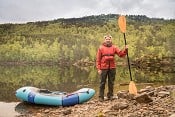In reply to Trangia:
> I suspect that the simple answer to your question is no!
I suspected as much!
> It's a huge range of conditions that you are looking at, and you are unlikely to need mountaineering boots suitable for climbing at 6500m in the Andes, for summer use in Scotland, if I am reading your post correctly.
Yes, you read (almost) correctly - Scottish winter, summer alpine, and further afield. Essentially places where crampons are required. I was hoping there might be a cunning compromise, because - well let's face it, one pair of boots is quite expensive. Two very specialised pairs of boots in the space of twelve months is very expensive, and a tough sell to someone who also needs crampons, axe, etc.
That said, maybe I could arrange a day out in the northern corries in typical Scottish conditions, put her off the idea entirely and save her a vast sum of money.
> At 3m in the Andes, I don't think you need to worry about your feet being too cold!! - nice typo !!
Whoops I suspect you may be correct.









